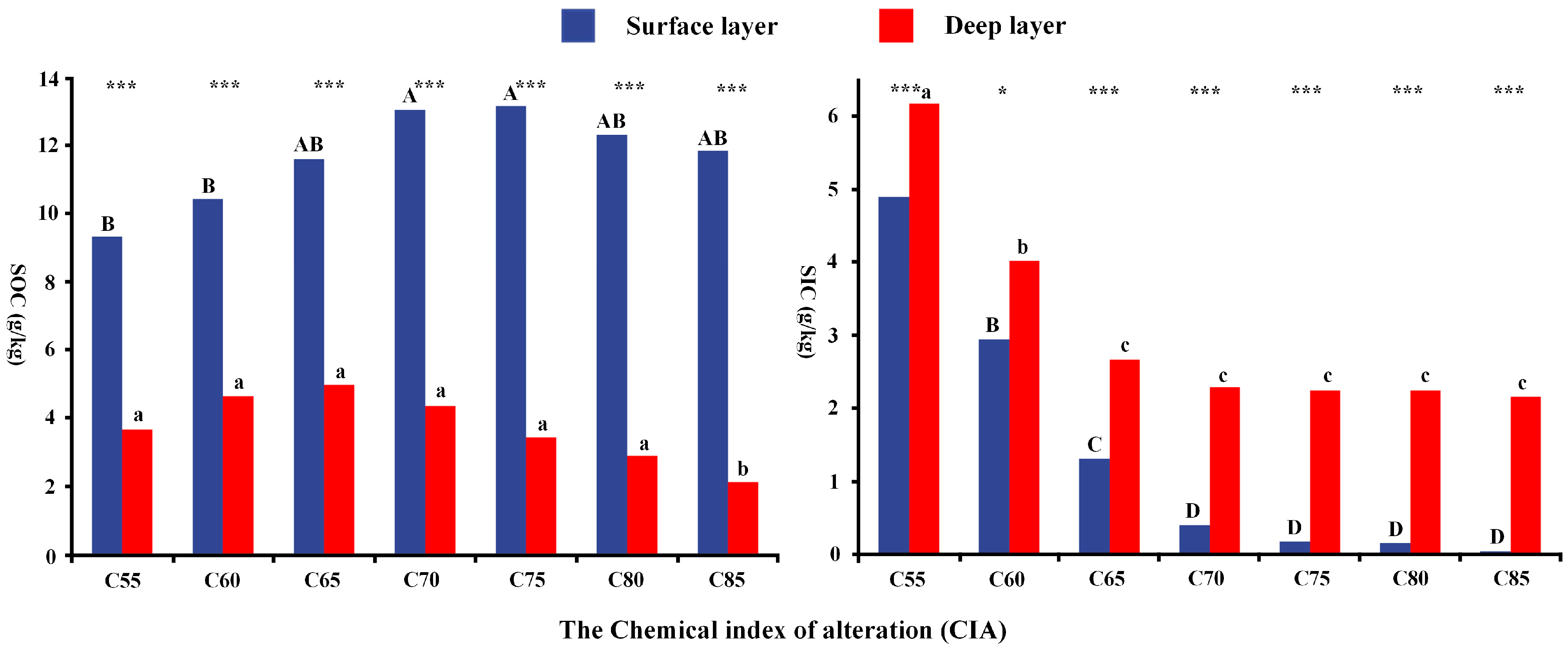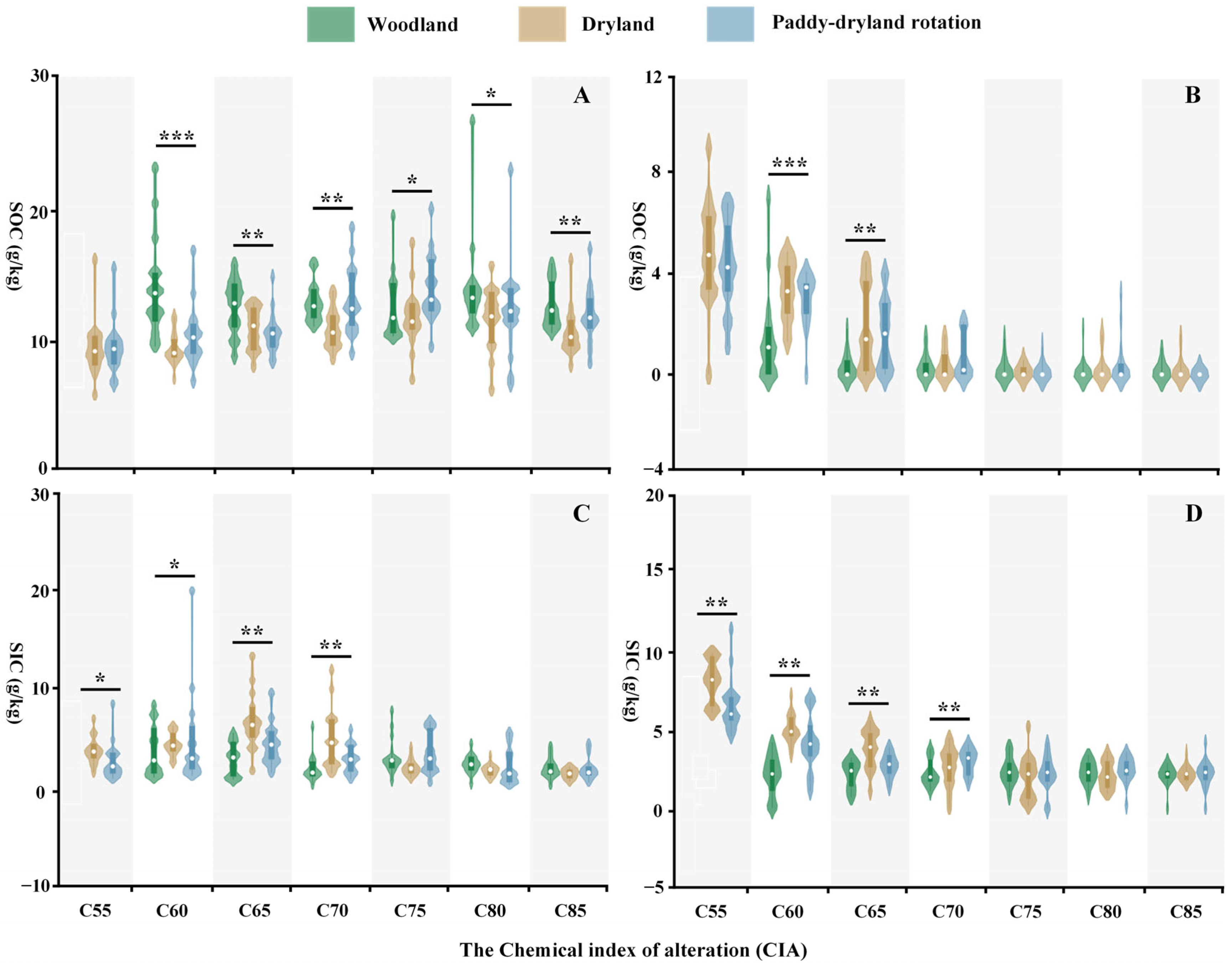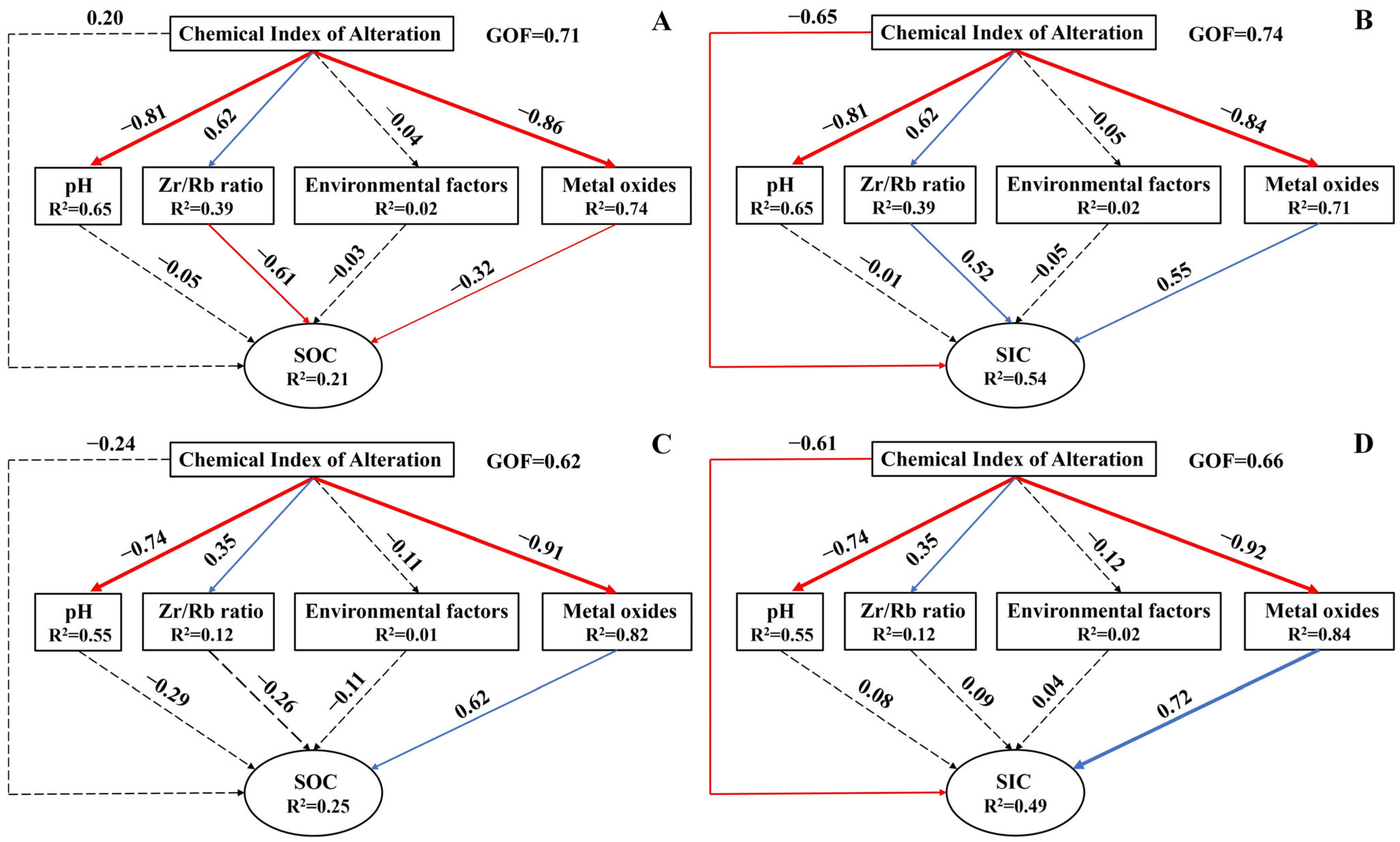Responses of Soil Organic/Inorganic Carbon Concentrations in the Lower Yangtze River to Soil Development and Land Use
Abstract
1. Introduction
2. Materials and Methods
2.1. Study Area
2.2. Soil Samples and Chemical Analysis
2.3. Data Collection
2.4. Factor Importance Identification for OC and IC
3. Results
3.1. Descriptive Statistics
3.2. Spatial Distribution of SOC and SIC in Surface and Deep Layers
3.3. The Dynamics of SOC and SIC Content Along the Chronosequence
3.4. SOC and SIC Content Dynamics over Different Land Uses Along the Chronosequence
3.5. Factor Importance for SOC and SIC
4. Discussion
4.1. The Effect of Pedogenic Stage Variables on Soil OC and IC Heterogeneity
4.2. Effects of Land Use on the Spatial Variation of SOC and SIC
4.3. Evolution of Soil Properties and Their Regulation on SOC and SIC
4.4. Implications for C Storage in the Downstream of the Yangtze River
5. Conclusions
Supplementary Materials
Author Contributions
Funding
Institutional Review Board Statement
Informed Consent Statement
Data Availability Statement
Conflicts of Interest
References
- Hu, K.L.; Li, H.; Li, B.G.; Huang, Y.F. Spatial and temporal patterns of soil organic matter in the urban-rural transition zone of Beijing. Geoderma 2007, 141, 302–310. [Google Scholar] [CrossRef]
- Cui, J.; Liu, C.; Li, Z.L.; Wang, L.; Chen, X.F.; Ye, Z.Z.; Fang, C.M. Long-term changes in topsoil chemical properties under centuries of cultivation after reclamation of coastal wetlands in the Yangtze Estuary, China. Soil Till Res. 2012, 123, 50–60. [Google Scholar] [CrossRef]
- Liao, Q.L.; Zhang, X.H.; Li, Z.P.; Pan, G.X.; Smith, P.; Jin, Y.; Wu, X.M. Increase in soil organic carbon stock over the last two decades in China’s Jiangsu Province. Glob. Change Biol. 2009, 15, 861–875. [Google Scholar] [CrossRef]
- Zhang, H.; Yin, A.; Yang, X.; Wu, P.; Fan, M.; Wu, J.; Zhang, M.; Gao, C. Changes in surface soil organic/inorganic carbon concentrations and their driving forces in reclaimed coastal tidal flats. Geoderma 2019, 352, 150–159. [Google Scholar] [CrossRef]
- Song, G.H.; Li, L.Q.; Pan, G.X.; Zhang, Q. Topsoil organic carbon storage of China and its loss by cultivation. Biogeochemistry 2005, 74, 47–62. [Google Scholar] [CrossRef]
- Song, X.Z.; Peng, C.H.; Zhou, G.M.; Jiang, H.; Wang, W.F. Chinese Grain for Green Program led to highly increased soil organic carbon levels: A meta-analysis. Sci. Rep. 2014, 4, 4460. [Google Scholar] [CrossRef]
- Wang, X.J.; Wang, J.P.; Xu, M.G.; Zhang, W.J.; Fan, T.L.; Zhang, J. Carbon accumulation in arid croplands of northwest China: Pedogenic carbonate exceeding organic carbon. Sci. Rep. 2015, 5, 11439. [Google Scholar] [CrossRef]
- Li, Z.P.; Han, F.X.; Su, Y.; Zhang, T.L.; Sun, B.; Monts, D.L.; Plodinec, M.J. Assessment of soil organic and carbonate carbon storage in China. Geoderma 2007, 138, 119–126. [Google Scholar]
- Mi, N.; Wang, S.Q.; Liu, J.Y.; Yu, G.R.; Zhang, W.J.; Jobbágy, E. Soil inorganic carbon storage pattern in China. Glob. Change Biol. 2008, 14, 2380–2387. [Google Scholar]
- Wang, D.D.; Shi, X.Z.; Wang, H.J.; Yu, D.S.; Sun, W.X.; Zhao, Y.C. Response of soil organic carbon spatial variability to the expansion of scale in the uplands of Northeast China. Geoderma 2010, 154, 302–310. [Google Scholar] [CrossRef]
- Li, C.; Li, Q.i.; Zhao, L.; Ge, S.; Chen, D.; Dong, Q.; Zhao, X. Land-use effects on organic and inorganic carbon patterns in the topsoil around Qinghai Lake basin, Qinghai-Tibetan Plateau. Catena 2016, 147, 345–355. [Google Scholar]
- Bradford, M.A.; Wieder, W.R.; Bonan, G.B.; Fierer, N.; Raymond, P.A.; Crowther, T.W. Managing uncertainty in soil carbon feedbacks to climate change. Nat. Clim. Change 2016, 6, 751–758. [Google Scholar] [CrossRef]
- Jobbagy, E.G.; Jackson, R.B. The vertical distribution of soil organic carbon and its relation to climate and vegetation. Ecol. Appl. 2000, 10, 423–436. [Google Scholar]
- Miller, A.J.; Amundson, R.; Burke, I.C.; Yonker, C. The effect of climate and cultivation on soil organic C and N. Biogeochemistry 2004, 67, 57–72. [Google Scholar]
- Tan, W.F.; Zhang, R.; Cao, H.; Huang, C.Q.; Yang, Q.K.; Wang, M.K.; Koopal, L.K. Soil inorganic carbon stock under different soil types and land uses on the Loess Plateau region of China. Catena 2014, 121, 22–30. [Google Scholar]
- Su, B.W.; Zhang, H.; Zhang, Y.L.; Shao, S.S.; Abdul, M.M.; Jiao, H.; Yi, S.W.; Gao, C. Soil C:N:P Stoichiometry Succession and Land Use Effect After Intensive Reclamation: A Case Study on the Yangtze River Floodplain. Agronomy 2023, 13, 1133. [Google Scholar] [CrossRef]
- Cheng, Y.Q.; Yang, L.Z.; Cao, Z.H.; Ci, E.; Yin, S. Chronosequential changes of selected pedogenic properties in paddy soils as compared with non-paddy soils. Geoderma 2009, 151, 31–41. [Google Scholar]
- Wang, Z.P.; Han, X.G.; Chang, S.X.; Wang, B.; Yu, Q.; Hou, L.Y.; Li, L.H. Soil organic and inorganic carbon contents under various land uses across a transect of continental steppes in Inner Mongolia. Catena 2013, 109, 110–117. [Google Scholar] [CrossRef]
- Benbi, D.K.; Toor, A.S.; Kumar, S. Management of organic amendments in rice-wheat cropping system determines the pool where carbon is sequestered. Plant Soil 2012, 360, 145–162. [Google Scholar] [CrossRef]
- Wang, J.; Zhuang, S.Y.; Zhu, Z.L. Soil organic nitrogen composition and mineralization of paddy soils in a cultivation chronosequence in China. J. Soil Sediments 2017, 17, 1588–1598. [Google Scholar] [CrossRef]
- Zhang, H.; Wu, P.; Yin, A.; Yang, X.; Zhang, X.; Zhang, M.; Gao, C. Organic carbon and total nitrogen dynamics of reclaimed soils following intensive agricultural use in eastern China. Agric. Ecosyst. Environ. 2016, 235, 193–203. [Google Scholar]
- Chang, R.; Fu, B.; Liu, G.; Wang, S.; Yao, X. The effects of afforestation on soil organic and inorganic carbon: A case study of the Loess Plateau of China. Catena 2012, 95, 145–152. [Google Scholar]
- Lal, R. Soil carbon sequestration to mitigate climate change. Geoderma 2004, 123, 1–22. [Google Scholar]
- Lilly, A.; Baggaley, N.J. The potential for Scottish cultivated topsoils to lose or gain soil organic carbon. Soil Use. Manag. 2013, 29, 39–47. [Google Scholar]
- Qafoku, N.P. Chapter Two—Climate-Change Effects on Soils: Accelerated Weathering, Soil Carbon, and Elemental Cycling. Adv. Agron. 2015, 131, 111–172. [Google Scholar]
- Rowley, M.C.; Grand, S.; Adatte, T.; Verrecchia, E.P. A cascading influence of calcium carbonate on the biogeochemistry and pedogenic trajectories of subalpine soils, Switzerland. Geoderma 2020, 361, 114065. [Google Scholar]
- Zhang, H.; Wu, P.B.; Fan, M.M.; Zheng, S.Y.; Wu, J.T.; Yang, X.H.; Zhang, M.; Yin, A.J.; Gao, C. Dynamics and driving factors of the organic carbon fractions in agricultural land reclaimed from coastal wetlands in eastern China. Ecol. Indic. 2018, 89, 639–647. [Google Scholar]
- Han, X.Y.; Gao, G.Y.; Chang, R.Y.; Li, Z.S.; Ma, Y.; Wang, S.; Wang, C.; Lu, Y.H.; Fu, B.J. Changes in soil organic and inorganic carbon stocks in deep profiles following cropland abandonment along a precipitation gradient across the Loess Plateau of China. Agric. Ecosys. Environ. 2018, 258, 1–13. [Google Scholar]
- Stockmann, U.; Adams, M.A.; Crawford, J.W.; Field, D.J.; Henakaarchchi, N.; Jenkins, M.; Minasny, B.; McBratney, A.B.; de Courcelles, V.D.; Singh, K.; et al. The knowns, known unknowns and unknowns of sequestration of soil organic carbon. Agric. Ecosyst. Environ. 2013, 164, 80–99. [Google Scholar]
- Mao, D.H.; Wang, Z.M.; Li, L.; Miao, Z.H.; Ma, W.H.; Song, C.C.; Ren, C.Y.; Jia, M.M. Soil organic carbon in the Sanjiang Plain of China: Storage, distribution and controlling factors. Biogeosciences 2015, 12, 1635–1645. [Google Scholar]
- Nesbitt, H.W.; Young, G.M. Early proterozoic climates and plate motions inferred from major element chemistry of lutites. Nature 1982, 299, 715–717. [Google Scholar]
- Fan, M.M.; Lal, R.; Zhang, H.; Margenot, A.J.; Wu, J.T.; Wu, P.B.; Zhang, L.M.; Yao, J.T.; Chen, F.R.; Gao, C. Variability and determinants of soil organic matter under different land uses and soil types in eastern China. Soil Till Res. 2020, 198, 104544. [Google Scholar]
- Kylander, M.E.; Ampel, L.; Wohlfarth, B.; Veres, D. High-resolution X-ray fluorescence core scanning analysis of Les Echets (France) sedimentary sequence: New insights from chemical proxies. J. Quat. Sci. 2011, 26, 109–117. [Google Scholar]
- Nelson, D.W.; Sommers, L.E. Total carbon, organic carbon and organic matter. In Methods of Soil Analysis Part 2, 2nd ed.; Page, A.L., Miller, R.H., Kenney, D.R., Eds.; American Society of Agronomy: Madison, WI, USA, 1982; pp. 539–577. [Google Scholar]
- Zhao, Z.W.; Wu, Y.; Chen, W.J.; Sun, W.; Wang, Z.H.; Liu, G.B.; Xue, S. Soil enzyme kinetics and thermodynamics in response to long-term vegetation succession. Sci. Total Environ. 2023, 882, 163542. [Google Scholar]
- Wang, Y.S.; Li, C.N.; Tu, B.; Kou, Y.P.; Li, X.Z. Species pool and local ecological assembly processes shape the β-diversity of diazotrophs in grassland soils. Soil Biol. Biochem. 2021, 160, 108338. [Google Scholar]
- Huggett, R.J. Soil chronosequences, soil development, and soil evolution: A critical review. Catena 1998, 32, 155–172. [Google Scholar]
- Kalbitz, K.; Kaiser, K.; Fiedler, S.; Kolbl, A.; Amelung, W.; Brauer, T.; Cao, Z.; Don, A.; Grootes, P.; Jahn, R.; et al. The carbon count of 2000 years of rice cultivation. Glob. Change Biol. 2013, 19, 1107–1113. [Google Scholar]
- Wissing, L.; Kolbl, A.; Vogelsang, V.; Fu, J.R.; Cao, Z.H.; Kogel, K.I. Organic carbon accumulation in a 2000-year chronosequence of paddy soil evolution. Catena 2011, 87, 376–385. [Google Scholar]
- Wang, L.; Ying, R.R.; Shi, J.Q.; Long, T.; Lin, Y.S. Advancement in study on adsorption of organic matter on soil minerals and its mechanism. Acta Pedol. Sin. 2017, 54, 805–818. [Google Scholar]
- Li, Q.; Chen, D.D.; Zhao, L.; Yang, X.; Xu, S.X.; Zhao, X.Q. More than a century of Grain for Green Program is expected to restore soil carbon stock on alpine grassland revealed by field 13C pulse labeling. Sci. Total Environ. 2016, 550, 17–26. [Google Scholar]
- Du, C.J.; Gao, Y.H. Opposite patterns of soil organic and inorganic carbon along a climate gradient in the alpine steppe of northern Tibetan Plateau. Catena 2020, 186, 104366. [Google Scholar]
- Yang, P.P.; Shu, Q.; Liu, Q.; Hu, Z.; Zhang, S.J.; Ma, Y.Y. Distribution and factors influencing organic and inorganic carbon in surface sediments of tidal flats in northern Jiangsu, China. Ecol. Indic. 2021, 126, 107633. [Google Scholar]
- Carmi, I.; Kronfeld, J.; Moinester, M. Sequestration of atmospheric carbon dioxide as inorganic carbon in the unsaturated zone under semi-arid forests. Catena 2019, 173, 93–98. [Google Scholar]
- Liu, W.G.; Wei, J.; Cheng, J.M.; Li, W.J. Profile distribution of soil inorganic carbon along a chronosequence of grassland restoration on a 22-year scale in the Chinese Loess Plateau. Catena 2014, 121, 321–329. [Google Scholar]
- Shi, H.J.; Wang, X.J.; Zhao, Y.J.; Xu, M.G.; Li, D.W.; Guo, Y. Relationship between soil inorganic carbon and organic carbon in the wheat-maize cropland of the North China Plain. Plant Soil 2017, 418, 423–436. [Google Scholar]
- Wei, L.; Ge, T.D.; Zhu, Z.K.; Ye, R.Z.; Penuelas, J.; Li, Y.; Lynn, T.M.; Jones, D.L.; Wu, J.S.; Kuzyakov, Y. Paddy soils have a much higher microbial biomass content than upland soils: A review of the origin, mechanisms, and drivers. Agric. Ecosyst. Environ. 2022, 326, 107798. [Google Scholar]
- Wang, D.D.; Shi, X.Z.; Wang, H.J.; Weindorf, D.C.; Yu, D.S.; Sun, W.X.; Ren, H.Y.; Zhao, Y.C. Scale effect of climate and soil texture on soil organic carbon in the uplands of Northeast China. Pedosphere 2010, 20, 525–535. [Google Scholar]
- Zhang, Y.; Liu, S.Y.; Cheng, Y.; Cai, Z.C.; Müller, C.; Zhang, J.B. Composition of soil recalcitrant C regulates nitrification rates in acidic soils. Geoderma 2019, 337, 965–972. [Google Scholar]
- Andrew, T.N.; Patrick, M.; Esther, V.; Benjamin, L.T. Soil carbon loss by experimental warming in a tropical forest. Nature 2020, 584, 234–237. [Google Scholar]
- Bogunovic, I.; Trevisani, S.; Pereira, P.; Vukadinovic, V. Mapping soil organic matter in the Baranja region (Croatia): Geological and anthropic forcing parameters. Sci. Total Environ. 2018, 643, 335–345. [Google Scholar]
- Bellamy, P.H.; Loveland, P.J.; Bradley, R.I.; Lark, R.M.; Kirk, G.J.D. Carbon losses from all soils across England and Wales 1978–2003. Nature 2005, 437, 245–248. [Google Scholar] [PubMed]
- Deng, L.; Shangguan, Z.P.; Wu, G.L.; Chang, X.F. Effects of grazing exclusion on carbon sequestration in China’s grassland. Earth Sci. Rev. 2017, 173, 84–95. [Google Scholar]
- Raheb, A.; Heidari, A.; Mahmoodi, S. Organic and inorganic carbon storage in soils along an arid to dry sub-humid climosequence in northwest of Iran. Catena 2017, 153, 66–74. [Google Scholar]
- Hassink, J. The capacity of soils to preserve organic C and N by their association with clay and silt particles. Plant Soil 1997, 191, 77–87. [Google Scholar]
- Kindler, R.; Siemens, J.; Kaiser, K.; Walmsley, D.C.; Bernhofer, C.; Buchmann, N.; Cellier, P.; Eugster, W.; Gleixner, G.; Grunwald, T. Dissolved carbon leaching from soil is a crucial component of the net ecosystem carbon balance. Glob. Change Biol. 2011, 17, 1167–1185. [Google Scholar]
- Jandl, R.; Lindner, M.; Vesterdal, L.; Bauwens, B.; Baritz, R.; Hagedorn, F.; Johnson, D.W.; Minkkinen, K.; Byrne, K.A. How strongly can forest management influence soil carbon sequestration? Geoderma 2007, 137, 253–268. [Google Scholar]
- Smith, J.; Smith, P.; Wattenbach, M.; Zaehle, S.; Hiederer, R.; Jones, R.J.A.; Montanarella, L.; Rounsevell, M.D.A.; Reginster, I.; Ewert, F. Projected changes in mineral soil carbon of European croplands and grasslands, 1990–2080. Glob. Change Biol. Bioenergy 2005, 11, 2141–2152. [Google Scholar]





| Land Use | Index | Surface Layer | Deep Layer | ||||||||
|---|---|---|---|---|---|---|---|---|---|---|---|
| Min | Max | Mean | SD | C.V. | Min | Max | Mean | SD | C.V. | ||
| Woodland | SOC | 8.09 | 26.7 | 12.9 a | 2.45 | 19.1 | 0.50 | 8.60 | 2.84 b | 1.52 | 53.5 |
| SIC | 0 | 7.14 | 0.34 b | 0.86 | 254 | 0 | 7.70 | 2.31 a | 0.93 | 40.3 | |
| Dryland | SOC | 5.98 | 18.3 | 10.9 a | 2.10 | 19.2 | 0.80 | 13.5 | 4.41 b | 2.50 | 56.7 |
| SIC | 0 | 9.20 | 1.75 b | 2.11 | 121 | 0 | 8.30 | 3.43 a | 1.89 | 55.1 | |
| Paddy–dryland rotation | SOC | 5.71 | 25.8 | 12.8 a | 2.33 | 18.3 | 0.30 | 22.8 | 3.35 b | 2.61 | 77.8 |
| SIC | 0 | 7.03 | 0.39 b | 1.02 | 259 | 0 | 11.4 | 2.60 a | 1.37 | 52.8 |
| SOC | SOC* | SIC | SIC* | |
|---|---|---|---|---|
| CIA | 0.20 * | −0.25 * | −0.66 * | −0.63 * |
| pH | −0.10 | 0.14 | 0.51 * | 0.49 * |
| Ca2+ | 0.24 * | 0.26 * | 0.72 * | 0.67 * |
| Al3+ | 0.23 * | 0.37 * | 0.12 | −0.30 * |
| Mg2+ | 0.03 | 0.41 * | 0.15 | 0.42 * |
| Fe3+ | 0.02 | 0.17 | 0.70 * | 0.10 |
| Si4+ | −0.03 | −0.44 * | 0.10 | −0.36 * |
| K+ | 0.03 | 0.36 * | 0.01 | 0.10 |
| Na+ | 0.03 | 0.10 | 0.10 | 0.24 * |
| Zr/Rb ratio | −0.17 | −0.39 * | 0.22 * | 0.10 |
| NDVI | 0.07 | 0.15 | −0.17 | 0.03 |
| Evaporation | 0.01 | 0.10 | 0.01 | 0.10 |
| Precipitation | −0.05 | 0.04 | 0.02 | 0.10 |
| Temperature | −0.10 | −0.02 | 0.03 | 0.05 |
| Elevation | 0.05 | 0.02 | 0.03 | −0.04 |
Disclaimer/Publisher’s Note: The statements, opinions and data contained in all publications are solely those of the individual author(s) and contributor(s) and not of MDPI and/or the editor(s). MDPI and/or the editor(s) disclaim responsibility for any injury to people or property resulting from any ideas, methods, instructions or products referred to in the content. |
© 2025 by the authors. Licensee MDPI, Basel, Switzerland. This article is an open access article distributed under the terms and conditions of the Creative Commons Attribution (CC BY) license (https://creativecommons.org/licenses/by/4.0/).
Share and Cite
Su, B.; Gao, C.; Shao, S.; Zhang, Y. Responses of Soil Organic/Inorganic Carbon Concentrations in the Lower Yangtze River to Soil Development and Land Use. Agronomy 2025, 15, 850. https://doi.org/10.3390/agronomy15040850
Su B, Gao C, Shao S, Zhang Y. Responses of Soil Organic/Inorganic Carbon Concentrations in the Lower Yangtze River to Soil Development and Land Use. Agronomy. 2025; 15(4):850. https://doi.org/10.3390/agronomy15040850
Chicago/Turabian StyleSu, Baowei, Chao Gao, Shuangshuang Shao, and Yalu Zhang. 2025. "Responses of Soil Organic/Inorganic Carbon Concentrations in the Lower Yangtze River to Soil Development and Land Use" Agronomy 15, no. 4: 850. https://doi.org/10.3390/agronomy15040850
APA StyleSu, B., Gao, C., Shao, S., & Zhang, Y. (2025). Responses of Soil Organic/Inorganic Carbon Concentrations in the Lower Yangtze River to Soil Development and Land Use. Agronomy, 15(4), 850. https://doi.org/10.3390/agronomy15040850





